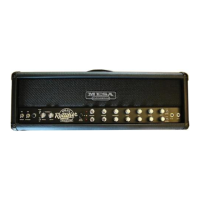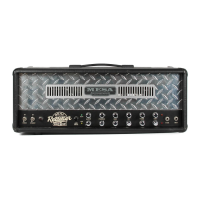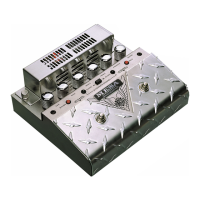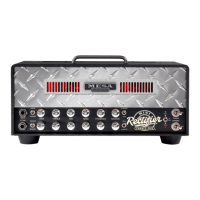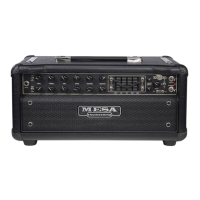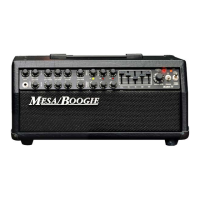PAGE 9
BASS:
The BASS is probably the simplest control on the TA-15 and it simply dials in low frequencies to the mix in the preamp sec-
tion. It is a less “volatile” Tone control than the TREBLE in that high settings will only cause an unbalanced sound, and not some other
“stress” issue on the tubes or circuit. There is not really even a danger in speaker damage due to extreme settings
as there might be in some higher power amps - as the power available in the TA-15 is not usually considered high
enough to be dangerous to most speakers.
Really, the main thing to keep in mind regarding the setting of the BASS control is to avoid dialing in too much and
creating a flubby sound with compromised attack characteristics. Remember the old rule we mentioned earlier in
the HELPFUL HINTS section… as the GAIN goes up the BASS should come down. While this is pretty general and
maybe too all-encompassing, keeping it in mind will help you get to a great sound faster.
It is especially important not to run the BASS too high when searching for clipped sounds in the NORMAL (and sometimes TOP
BOOST) Mode of Channel 1 and the TWEED Mode of Channel 2. When the GAIN is maxed out here things can get kind of ugly in
the low end fast.
CUT (knob pushed in):
This push-pull control is only found in Channel 1 and is responsible for determining the blend of high
frequencies allowed to pass in the power section in that Channel. It works backward of most controls in that when it is increased
(clockwise) you are increasing the “cut” of the high frequencies and therefore the sound is becoming darker and less
bright. This takes some getting used to if you haven’t used one of these circuits before. It really is like a reverse
PRESENCE control and if you think of it as such, it may help you in navigating the possibilities found here.
The taper of the pot used in the CUT control is a very slow one and was chosen because it is rare that you will use
the control at its very highest (most rolled-off) setting. This way there is more fine resolution available to allow you
to dial in just the right amount of “cut”. The only time you might find the extreme high region of the CUT appropriate
is for fat single note solo sounds where it can remove huge amounts of sizzle and make things sound fat.
PULL MASTER (knob pulled out):
As mentioned in the VOLUME/GAIN control description, the CUT control is fitted with an inge-
nious “mod” to the original “vintage” architecture and incorporates a pull pot that, when engaged, transforms the CUT into a MASTER
volume control. When the MASTER function is engaged, the CUT is preset automatically to a setting of around 1/3 or
in other words - 11:00 and this may not be altered as long as the control is pulled out and the MASTER is active.
This feature greatly enhances the flexibility of Channel 1 and allows you to, unlike the original, use these sounds for
an extremely wide array of both classic and modern sounds. It also allows you to create many more footswitchable
Channel matches than would have otherwise been possible. And as for the purists you may come across who -
in probable jealousy – try to point out the original version’s urgency, openness and dynamic character, you can
politely agree, smile and then walk over and push in the MASTER and ask them if they want to try your “vintage”
rendering.
When you need the old-school response of the original “no-master” circuit - and the gain versus volume issues that inherently arise
from this scenario are not a problem - the original vintage architecture can’t be beat. But when you need independent control over
both gain and volume, there is little doubt that whatever the (miniscule) tonal trade-off for this stripped “no-master” approach is easy
to overlook when it comes with the incredible flexibility it grants in return.
FRONT PANEL: Controls & Features (Continued)
NORMAL
15
TOP BST
25W
FT
SW
5W
MASTER
PULL
CUT /
NORMAL
15
TOP BST
25W
FT
SW
5W
MASTER
PULL
CUT /
CAUTION:
Unplug power
before replacing
fuse
120 V~
60 Hz
1 A
1.25 A
SLO
BLO
SPEAKERS
8 OHM
PATENTED
6,621,907
7,173,488
7,602,927
CAUTION: CHASSIS SURFACE MAY BE HOT!
4 OHM
TRANSATLANTIC
TA -15
HANDBUILT IN PETALUMA, CAALL T UBE AMPLIFIER
®
CAUTION!
WARNING!
TUBE GUIDE
4 x 12AX7
2 x EL 84
F
U
S
E
F
U
S
E
INPUT
FT SW
VOLUME TREBLE BASS GAIN TREBLE BASS MASTER
POWER
STANDBY
NORMAL
15 15
HI 1
TOP BST
25W
FT
SW
5W
TWEED
HI 2
25W
5W
ON
ON
MASTER
PULL
CUT /
™
-15
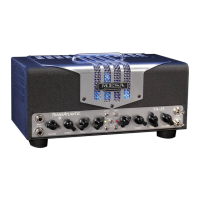
